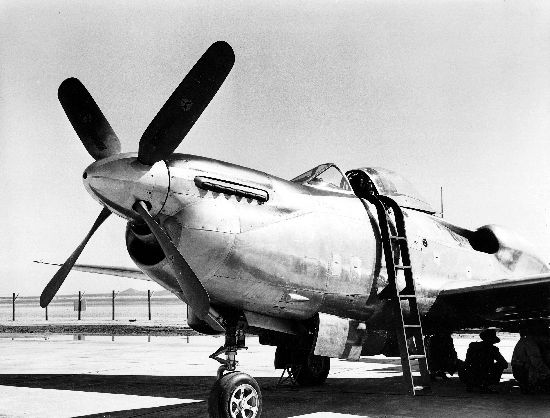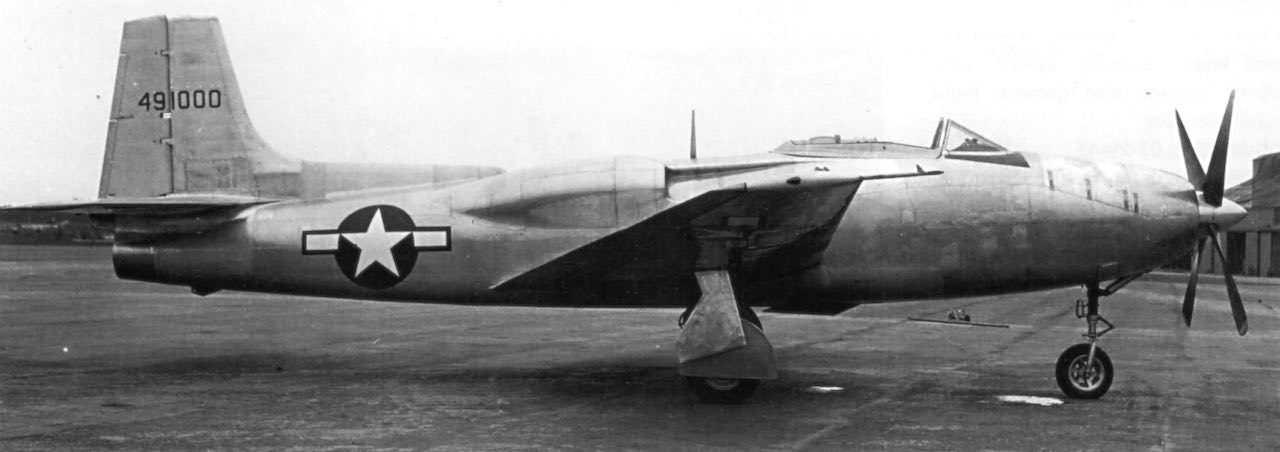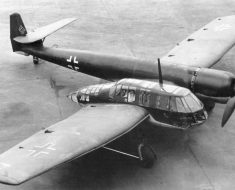The XP-81, a fighter aircraft that, despite its innovative features, remained largely a footnote in the story of military aviation.
Contents
The Genesis of the XP-81
Developed during the tumultuous years of World War II, the Convair XP-81 was conceived as a response to the growing need for long-range escort fighters capable of accompanying bombers deep into enemy territory.
The United States Army Air Forces (USAAF) recognised the limitations of existing fighters in terms of range and speed, thus commissioning Consolidated Vultee Aircraft Corporation (later Convair) to develop a solution.

Twin Engine Monster
The XP-81 was a groundbreaking design for its time, primarily due to its unique powerplant configuration. It was one of the first aircraft to be designed around a combination of a turbojet and a turboprop engine. This hybrid design aimed to provide the best of both worlds: the turboprop for fuel-efficient, long-range cruising, and the turbojet for high-speed combat performance.
Read More B-17 Wreck Exposed by Melting Glacier in Iceland
The twin-engine setup provided some notable advantages – the synergy between the two engine types, provided the aircraft with a versatile performance profile. The turbojet engine, situated in the rear, offered rapid acceleration and high-speed capabilities, essential for air superiority missions. The turboprop engine, located in the nose, contributed to an extended operational range, making the XP-81 well-suited for long-range escort missions.
However, this innovative configuration also presented challenges. The complexity of managing two different propulsion systems required sophisticated engineering and maintenance expertise. The integration of these engines demanded intricate control systems to ensure operation, adding to the aircraft’s overall complexity.

Additionally, the hybrid design faced issues during the XP-81’s early development, with delays in obtaining the intended turboprop engine affecting performance.
The twin-engine setup, while offering versatility, faced competition from more specialised and advanced jet-powered aircraft
Design
The airframe itself exhibited a modern and efficient design, featuring low-mounted wings with a slight sweep to optimise the aircraft for high-speed flight. The inclusion of a pressurised cockpit was a notable advancement, providing enhanced comfort and safety for the pilot during high-altitude operations. The XP-81 also adopted a tricycle landing gear, a relatively new concept at the time, contributing to improved ground handling.
In terms of armament, the XP-81 was equipped with six .50 calibre machine guns or four 20 mm cannons as well as provisions for underwing hardpoints to carry additional ordnance, emphasising its versatility for both air-to-air and air-to-ground combat roles.

The design allowed for the potential carriage of bombs or rockets, showcasing the aircraft’s adaptability to various mission requirements.
Read More The Handley Page HP.115, the Concorde Test Bed
While the XP-81 faced challenges during its development, including delays in obtaining the intended turboprop engine, its overall design reflected a commitment to pushing the boundaries of technology. The aircraft’s legacy lies not only in its operational capabilities but also in the lessons learned from its innovative design, influencing subsequent aircraft development in the post-war era.
Flight and Performance
The XP-81’s maiden flight occurred in February 1945. Initial tests showed promise, particularly in its handling and performance at high altitudes.
In terms of handling, the XP-81 was reported to exhibit smooth and stable flight characteristics. Pilots noted its responsiveness and overall ease of control, contributing to a positive flying experience. The tricycle landing gear, a relatively modern concept at the time, enhanced ground handling and provided improved stability during takeoff and landing.

However, the innovative powerplant concept also posed significant challenges. The turboprop engine, a General Electric XT31, was under development and did not become available until after the war’s end. As a result, early flights were conducted solely with the turbojet engine, a GE J33.
Challenges and Cancellation
One of the key factors leading to the cancellation was the end of the Second World War. With the conclusion of the conflict, there was a shift in military priorities, and the focus on long-range escort fighters diminished. The XP-81, designed to meet specific wartime requirements, found itself facing a changing strategic environment where different types of aircraft were now in demand.
Additionally, the rapid advancement of jet engine technology played a crucial role in the cancellation. The XP-81’s hybrid design, featuring both a turbojet and a turboprop engine, became somewhat obsolete with the increasing prevalence and effectiveness of pure jet-powered aircraft. Jet propulsion was proving to be more efficient, offering higher speeds and better performance compared to the hybrid configuration of the XP-81.

As a result, the U.S. Army Air Forces decided to terminate the XP-81 program in 1947. Only two prototypes were built, and the project did not progress to full-scale production. The cancellation marked the end of the road for the XP-81, despite its potential and the innovative aspects of its design.
Legacy and Conclusion
The XP-81, despite its brief and somewhat overshadowed existence, contributed valuable insights into aircraft design and propulsion. Its innovative approach to combining turboprop and turbojet power was ahead of its time and indicative of the experimental spirit that defined aviation development during and after World War II.

In retrospect, the XP-81 can be seen as a transitional aircraft, bridging the gap between the propeller-driven fighters of the early war years and the purely jet-powered aircraft that dominated the post-war era. Its story is a reminder of the relentless pace of technological change and the fleeting nature of military requirements in an ever-evolving landscape of war.
Read More The DINFIA IA 38: A Forgotten Chapter in Aviation History
The XP-81 stands as a testament to innovation, ambition, and the nature of military technology in the face of rapidly changing circumstances. Its legacy endures not just in the specific advancements it introduced, but also in the broader narrative of aviation development during one of the most dynamic periods in history.








